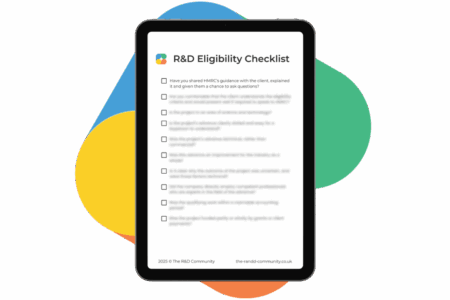The root cause of a problematic claim often lies in the project’s eligibility and how it’s explained and documented in the report. You’ll make your own life much easier if you can help your client understand:
- How HMRC defines R&D for tax purposes,
- What evidence is required to back up a claim,
- Their responsibility as a taxpayer claiming relief.
Explaining R&D tax relief to your SME clients
At the beginning of every claim, you’ll have an initial conversation with the client about their project and why it could be eligible for tax relief. This is when you should set your client’s expectations about what work qualifies for the scheme and ensure they’re prepared to play an active part in their claim’s preparation.
First things first, your client needs to have an up-to-date understanding of what constitutes R&D for tax purposes. Many SMEs still mistakenly believe that the definition of R&D is much broader than it actually is and are finding the correct definition much stricter than they imagined.
Our explainer on The Basics of R&D for SMEs might be a useful resource to send them alongside the definition found in HMRC’s guidance.
How to structure eligibility conversations with clients
Once that’s done, now you can move on discussing the projects. You should set the expectation from the outset that not every project may qualify, and that some may only qualify in part.
Your discussion needs to be sufficiently detailed to uncover which part of each project could be R&D – and what evidence they have to support it. A tool like our free R&D Eligibility Checklist can help you guide them through that conversation effectively.
By following a pre-set structure, you can ensure that you’ll get all the information you need to form a definitive opinion about whether each project would qualify for relief. Depending on the projects themselves, you may find it helpful to find a trusted colleague or mentor to talk through the facts with you and help you form that opinion.
Getting clarity on precisely which parts of the projects qualify for relief will give you and your client the confidence and peace of mind to move forward.
Another key function of the conversation is to make your client aware of how much evidence is required to support a claim, and how to build a strong project narrative. HMRC has become more demanding in the breadth and detail of evidence necessary to support a claim. Without proper evidence, claims are almost guaranteed to fail a detailed compliance check.
Highlighting the responsibilities of the taxpayer when claiming R&D tax relief
These are really important concepts for your client to understand because, ultimately, the claim is their responsibility. That means that they’re on the hook for penalties and enquiries, and HMRC lays this out clearly in their guidance. That fact might surprise them, but it’s true.
Including this as an agenda item in your initial eligibility conversations is essential. As a responsible advisor, you need to make sure the client knows exactly what they’re signing up for. This is especially important if they have worked with less rigorous advisors in the past, or seen marketing messages which suggest they can hand over everything to you and sit back.
Understanding and accepting that responsibility will motivate them to take an active part in the claim. So, while it might be an uncomfortable topic to bring up, it’s really important to do so as it’ll make everyone’s lives easier further down the line. HMRC’s Guidelines for Compliance (GfC3) are an excellent resource to help with this conversation.
Eligibility Conversations are pivotal to successful R&D tax relief claims
These early conversations about eligibility are the foundation upon which you build your client’s claim, so the pressure is really on to get them right. You’re not the only one dealing with these issues – we hear from advisors all the time who are finding them difficult to navigate.
Finding a mentor or support network can be really helpful in the long term for navigating tricky cases and clients. For an easy win, you can download our free R&D Eligibility Checklist and start using it to structure these conversations and build your own confidence in handling clients effectively.





